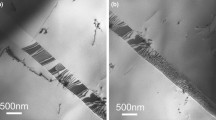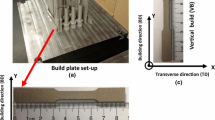Abstract
The creep and stress rupture behavior of a normalized 1.25 pct chromium-0.5 pct molybdenum steel has been investigated over a temperature (T) range of 510 to 620°C and a stress(σ) range of 65 to 425 MN/m2. The creep rate (\(\dot \in \)) and time to rupture (t r ) data have been analyzed in terms of the general expression\(\dot \in \) ort r -A σn exp (Q/RT), whereA is a constant,n is the power exponent of stress,Q is an empirical activation energy for the rate controlling process andR is the universal gas constant. At each temperature, the logarithmic plots of creep rate and time to rupture as functions of stress consist of two linear segments, separating the data into low stress and high stress regimes. The stress exponent has approximate values of 4 and 10 in the low stress and high stress regimes respectively in the appropriate expressions for both creep rate and for time to rupture. The activation energy has values of 367 and 420 kJ/mole in the low stress regime for time to rupture and creep rate respectively. In the high stress regime, the respective values of activation energy are 581 and 670 kJ/mole. Fractographic observations show that the changes from low stress to high stress behavior in creep rate and time to rupture approximately coincide with the transition in fracture mode from intergranular to transgranular cracking as well as with the transition in the rupture ductility from a region of linear variation with stress to one of constant ductility. These observations suggest that the transition from low stress to high stress behavior may be associated with a change in deformation mode from predominantly grain boundary sliding at low stress to transgranular matrix deformation at high stress. Analysis of the creep rate data based on this premise enables calculation of the ratio of the contributions of the grain boundary sliding mode to the total deformation (ε gb /ε T ) at various values of stress and temperature. Results of this analysis are consistent with numerous experimental observations reported in the literature.
Similar content being viewed by others
References
G. S. Ansell and S. Weertman:Trans. TMS-AIME, 1959, vol. 215, p. 838.
I. R. McLauchlin:Creep Strength in Steel and High Temperature Alloys, p. 86. The Metals Society, London, 1974.
J. M. Adamson and J. W. Martin:Ibid, p. 106.
J. M. Silcox and G. Willoughby:Ibid, p. 122.
F. E. Asbury and G. Willoughby:Ibid, p. 144.
M. J. Collins:Ibid, p. 217.
V. Foldyna, A. Jakobová, T. Prnka, and J. Sobotka:Ibid, p. 230.
P. L. Threadgill and B. Wilshire:Ibid, p. 8.
K. E. Amin and J. E. Dorn:Acta Met., 1969, vol. 17, p. 1429.
F. R. Beckitt, T. M. Banks, and T. Gladman:Creep Strength in Steels and High-Temperature Alloys, p. 71, The Metals Society, London, 1974.
V. Foldyna, A. Jakobova, T. Prnka, and J. Sobotka:Ibid., p. 230.
R. N. Stevens:Met. Rev., 1966, Review 108, vol. 11.
P. R. Strutt, A. M. Lewis, and R. C. Gifkins:J. Inst. Metals, 1964, vol. 93, p. 71.
R. L. Bell and T. G. Langdon:J. Mater. Sci., 1967, vol. 2, p. 313.
R. Lagneborg and R. Attermo:J. Mater. Sci., 1967 vol. 4, p. 195.
A. Gittins and R. C. Gifkins:J. Aust. Inst. Metals, 1969, vol. 14, p. 177.
R. C. Gifkins and K. V. Snowden:Trans. TMS-AIME 1967, vol. 239, p. 910.
R. C. Gifkins, A. Gittins, R. L. Bell, and T. G. Langdon:J. Mater. Sci. 1968, vol. 3, p. 306.
F. Garofalo:Fundamentals of Creep and Creep Rupture in Metals, The MacMillan Company, New York, N.Y., 1965.
F. Garafalo, C. Richmond, W. F. Domis, and F. VonGemmingen:Joint International Conference on Creep, 1st ed., pp. 1–31, Inst. Mech. Eng., London, 1963.
R. J. Borg and C. E. Birchenall:Trans. TMS-AIME, 1960, vol. 18, p. 980.
D. McClean and M. C. Farmer:J. Inst. Metals, 1956–57, vol. 85, p. 41.
F. C. Monkman and N. J. GrantDeformation and Fracture at Elevated Temperatures, p. 91, The M.I.T. Press, Cambridge, Mass., 1965.
Author information
Authors and Affiliations
Rights and permissions
About this article
Cite this article
Viswanathan, R. Effect of stress and temperature on the creep and rupture behavior of a 1.25 Pct chromium—0.5 Pct molybdenum steel. Metall Trans A 8, 877–884 (1977). https://doi.org/10.1007/BF02661568
Received:
Issue Date:
DOI: https://doi.org/10.1007/BF02661568




